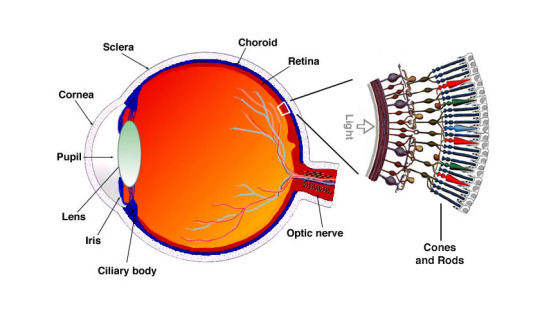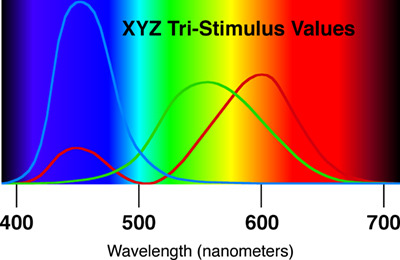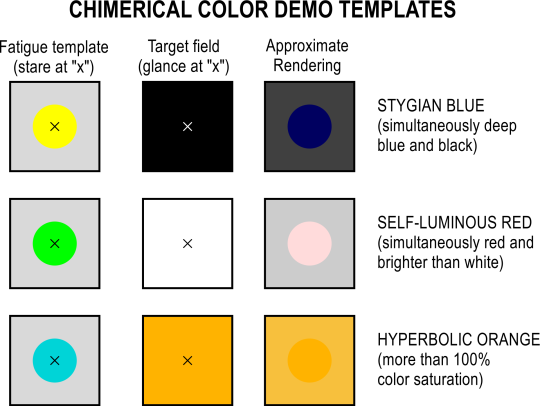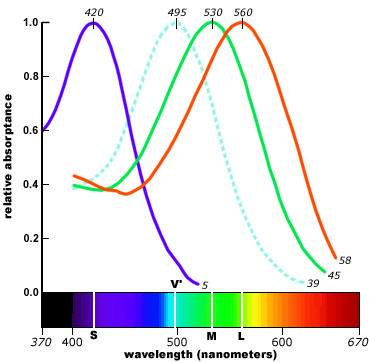Text
Impossible Colors
Ah, Rainbows. Bands of color that streak across the sky, water droplets refracting the Sun's brilliance into distinct bands that light up the world. Everyone knows what a Rainbow looks like, with stripes going from Red, to Orange, Yellow, Green, Indigo, and Violet. These (arguably) 6 colors make up all of human color perception, and combined with light, allow us to see the world around us.
As much as we would like to believe that these colors are concrete facts of reality and completely objective, they are not.
The EM Spectrum:

The light that our eyes detect is a very fractional percentage of electromagnetic radiation known as the visible light spectrum (shown above). This radiation is made up of extremely small particles called photons that move at the speed of light. As they move, they move up and down in a wave pattern. The frequency with which they move up and down depends on their energy, with measurements being defined as the distance between peaks. The lowest energy photons (like long wave radio) can take almost a kilometer to reach another peak, while in high energy photons such as gamma rays, the distance is so small it is measured in picometers, which for comparison is about ten percent the side of a hydrogen atom. The light that we see is much larger, ranging from 400 nanometers for violet to 700 nanometers for red, or about the size of a bacteria. There are animals that can see beyond this range, even our own eyes can just barely see UV light but it is blocked by the lenses in our eyes. People who have had their lenses remove describe the color as a whitish purple. Other examples include certain bees or birds. How do animals (humans included) see colors you ask? It all has to do in the retina.
Rods and Cones:
In animals such as humans that have so called camera eyes, visual processing lies in the retina, a region that occupies the inner lining of our eyes:

Within the retina there are around 100 million sensor cells. The vast majority are a type called rods, which are used for light perception, as in the intensity of the light hitting your eye. These can not perceive color (at least not well, more on that later), and very useful for nocturnal creatures who need to rely on seeing at night, such as cats. These are the cells that take over when you try and see in the dark. The other type of receptors, called cones, perceive color (frequency of the light) and are best in bright environments, and this is the area where humans truly shine, both because of our sheer number of cones (still only around 5 percent of sensors) as well as one other factor:
Cone Types:

Unlike the rods which are all tuned to see the same wavelength (somewhere between blue and red, again more on that later), our cones are able to detect different frequencies of visible light. The three types in humans are known as shortwave cones (blue), medium cones (green), and long wave cones (traditionally known as red, closer to an orangish yellow). As shown on the chart, there is significant overlap between the ranges of the 3 cones. This allows the brain to figure out colors other than red, green, and blue without needing more cones. It does it by comparing the relative stimulation between the the cones, and doing some math inside the brain in order to figure out which color it is. This allows us to see colors such as yellow and cyan, which there is no separate cone to detect but can be pieced out by combination of the red+green and orange+green cones respectively. Although, because we do not have a separate cone for those colors, we can only see our mind's approximation of them based on combining and averaging the two together. There are animals that have more cones, such as goldfish, who can properly perceive yellow, unlike humans. Most mammals such as dogs are lacking the green cone, which results in them not being able to perceive green, creating a spectrum that would look like the one below:

Humans have a similar phenomenon called Deuteronomy where the green cone is mutated and is almost identical to the red cone. It is the most common form of colorblindness, and so it might be worth getting checked out if the two images look similar.
Where the System Falls Apart:
If you look over to the left side of the red cone's perception, you can see that it does not go down linearly and that it has a small spike near the end. This can cause your blue and red cones to fire simultaneously with certain frequencies. The problem is that this occurs in two spots. There is the one you would expect at where green is, but also one near the violet area because of the abnormality in the red cone, causing you to see those two spots on the spectrum as the same. The problem is that one of these two intersections are green, which is a very very important color evolutionary for humans since most of the environment around our ancestors was green. It was very important to be able to tell green from blue because it could mean the difference between something edible and something lethal when foraging. To compensate for this, the green cone was added, creating the trichromatic vision that humans have (as well as some primates and marsupials). Great, this means our ancestors were able to green from blue, but it still leaves the problem of that anomalous spot in the blue region where the red and blue cones intersect. If the brain averaged their frequencies, it would result in the color being green, which would defeat the point of the green cone. The solution was to create a hypothetical color that would be a fusion of red and blue that activates when the green cone is not active. This color is called magenta, shown below:

There is no spot on the electromagnetic spectrum where red and blue meet, which results in this being our brain's approximation of what red and blue together would look like. Nothing can truly produce magenta light, and things that seem to like your computer monitor are simply combining red and blue light.
TLDR; Your ancestor's brains couldn't tell green apart from red and blue put together, so a system was added to distinguish green and magenta is what's left, which is what your brain thinks red and blue together would be, even though there is no point where those two colors intersect in the spectrum.
Other Impossible Colors:
Chimerical Colors:

These are colors that are achieved where you can manipulate your cones by intensely saturating them to "fatigue" them, which causes over correction when returning to a neutral point. You can try and see these for yourself by staring at the x's on the left for about 30 seconds, and then quickly looking at the middle x.
Red-Green and Yellow-Blue:


There are systems in place in your brain to prevent red and green + yellow and blue from firing together to prevent confusion. It does this by figuring out which cone is firing stronger, and giving priority in perception to that one. By trying to force the two to merge together, some people are able to see hypothetical fusions of the two, called Red-Green and Yellow-Blue. You can try this for yourself by crossing your eyes so the two crosses are one. The results are very interesting even if you don't see the new color.
Hyper Green:
The green cone has no point along its range where it doesn't inter lap with the other cones. When you look at green, one of your other cones is always firing. If it was possible to only cause the green cone to fire, someone might see a color that looks even greener than green, called hyper green. Sadly there is no way to try and replicate this yet since it would involve direct stimulation of your cones.
Bonus: Rod Color Perception

As mentioned before, the rods in your eyes do have their own range, shown as the blue dashed line. This means that your eyes are slightly more sensitive to greens and blues in the dark, and reds are much dimmer. This is known as the Purkinje Effect, and it has several applications such as red lighting on submarines and engine rooms to preserve night vision by not saturating the rods, or by using bright green and yellow jackets and fire engines at night to be more visible than the normal red.
That's all for now, stick around for more in-depth explanations on scientific concepts, as well as science memes and showcases of cool scientific applications
13 notes
·
View notes